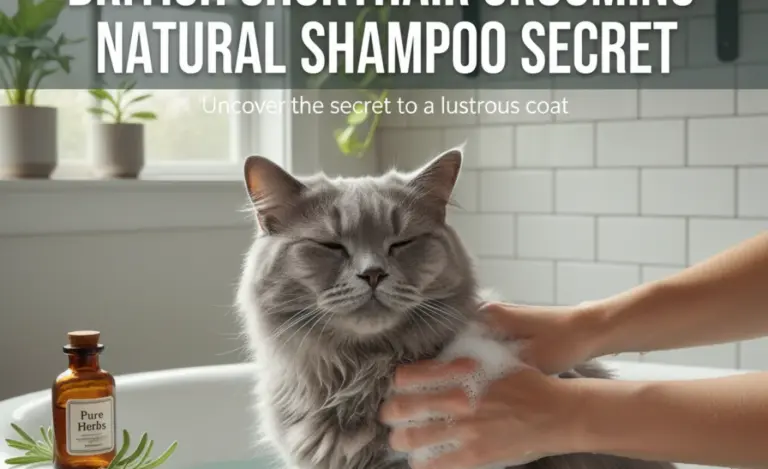How Often to Brush a British Shorthair? The Smart Guide
Quick Summary: For British Shorthairs, aim to brush them 2-3 times a week to prevent matting and reduce shedding. During shedding season (spring and fall), increase this to daily brushing. Regular grooming keeps their plush coat healthy, distributes skin oils, and minimizes hairballs. A happy cat and a cleaner home—it’s a win-win!
Is your British Shorthair leaving a trail of fur wherever they go? Don’t worry; it’s a common concern for owners of this beautiful breed! Their dense, plush coat is gorgeous but requires regular brushing to prevent mats and minimize shedding. Figuring out the perfect brushing schedule can feel tricky, but I’m here to help you create a simple routine that works for both you and your feline friend.
In this guide, I’ll walk you through how often to brush your British Shorthair, the best tools for the job, and some pro tips to make grooming a stress-free experience. Let’s get started and keep that coat looking its best!
Understanding the British Shorthair Coat
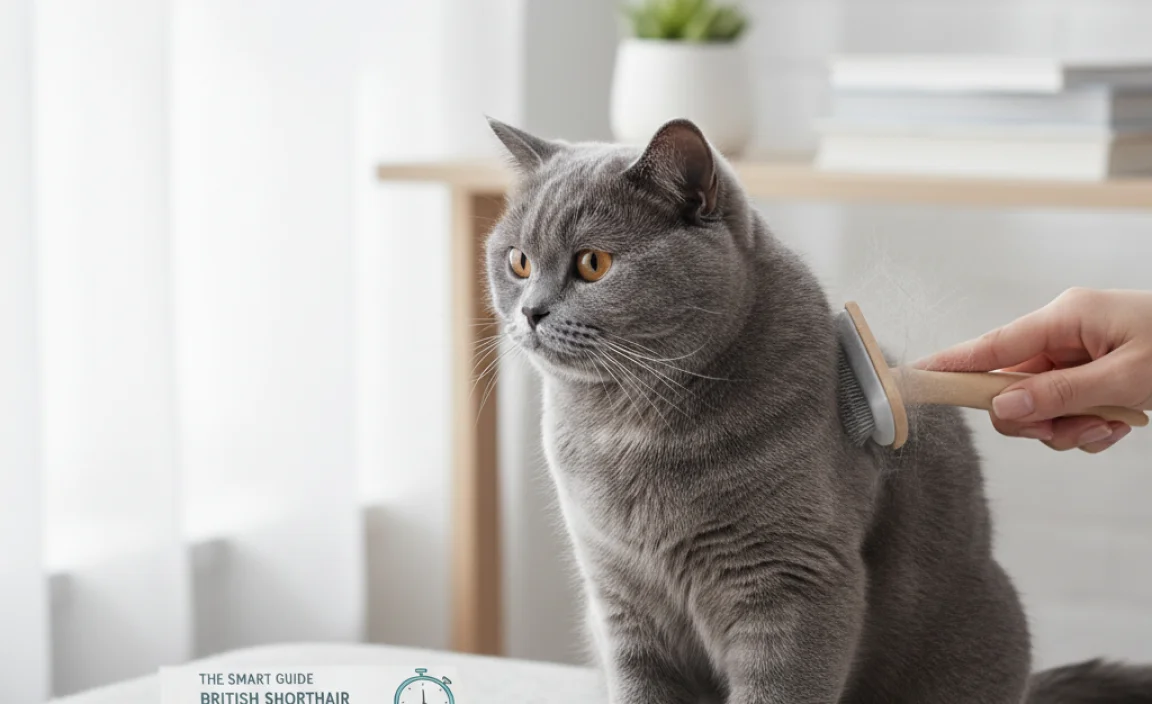
The British Shorthair’s coat is one of its most distinctive features. Unlike some breeds with a single layer of fur, the British Shorthair boasts a dense, plush double coat. This means they have a soft undercoat and a thicker, protective outer coat. While this double layer gives them a teddy bear-like appearance, it also means they require regular grooming to stay healthy and comfortable.
Why Regular Brushing Matters
Brushing your British Shorthair isn’t just about aesthetics; it’s essential for their health and well-being. Here’s why:
- Prevents Matting: The dense undercoat is prone to matting, especially if not brushed regularly. Mats can be painful and lead to skin irritation.
- Reduces Shedding: Regular brushing removes loose fur, preventing it from ending up on your furniture, clothes, and everywhere else.
- Minimizes Hairballs: When cats groom themselves, they ingest loose fur. Brushing helps reduce the amount of fur they swallow, which can prevent hairballs.
- Stimulates Circulation: Brushing promotes healthy blood flow to the skin, which can improve coat health and overall well-being.
- Strengthens the Bond: Grooming can be a bonding experience for you and your cat, creating a sense of trust and comfort.
How Often Should You Brush?
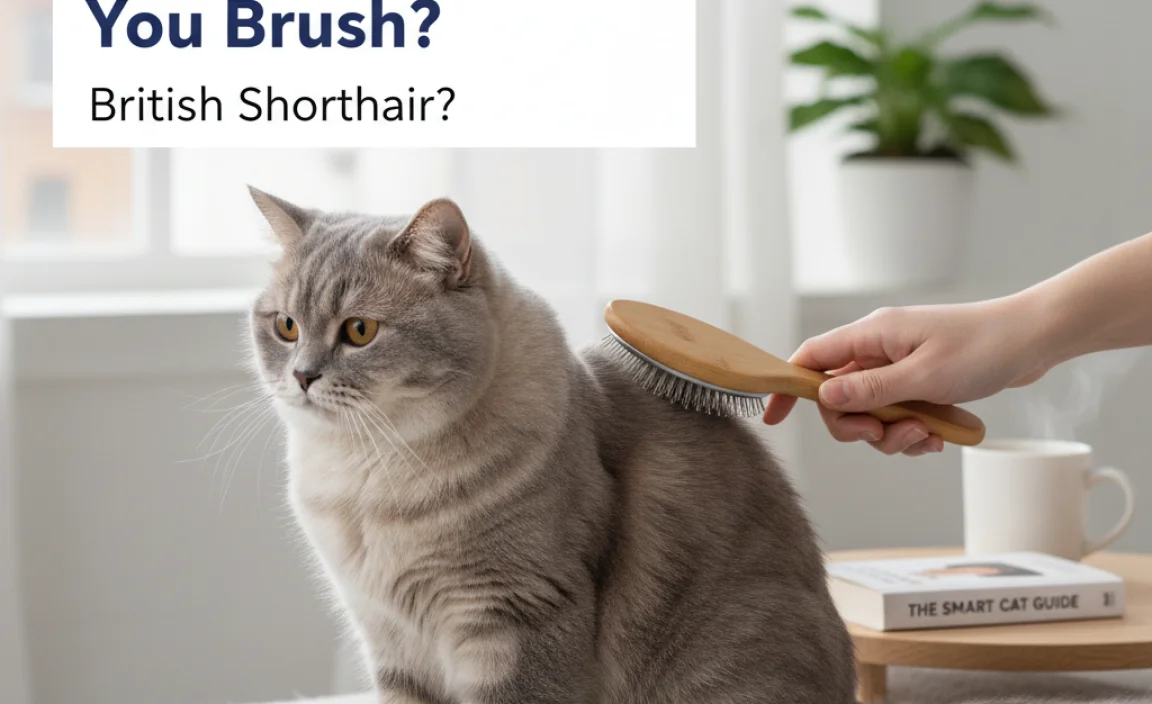
So, how often should you brush your British Shorthair? Here’s a general guideline:
- General Maintenance: 2-3 times per week
- During Shedding Season (Spring & Fall): Daily
Let’s break this down further.
Regular Brushing (2-3 Times a Week)
For most of the year, brushing your British Shorthair 2-3 times a week is sufficient. This routine helps remove loose fur, prevent matting, and keep their coat looking its best. Make it a regular part of your schedule, like Monday, Wednesday, and Friday, to stay consistent.
Increased Brushing During Shedding Season (Daily)
British Shorthairs typically shed more during the spring and fall. During these periods, daily brushing is highly recommended. This helps manage the increased shedding and prevents mats from forming. Think of it as a proactive approach to keep your home (and your cat) fur-free.
Factors That Influence Brushing Frequency
While the above guidelines are a great starting point, several factors can influence how often you need to brush your British Shorthair:
- Age: Kittens and senior cats may require more frequent brushing due to their grooming habits or mobility.
- Health: Cats with certain health conditions, such as arthritis, may have difficulty grooming themselves, requiring more assistance from you.
- Lifestyle: Indoor cats may shed less than outdoor cats, but they still need regular brushing to maintain their coat.
Choosing the Right Brush
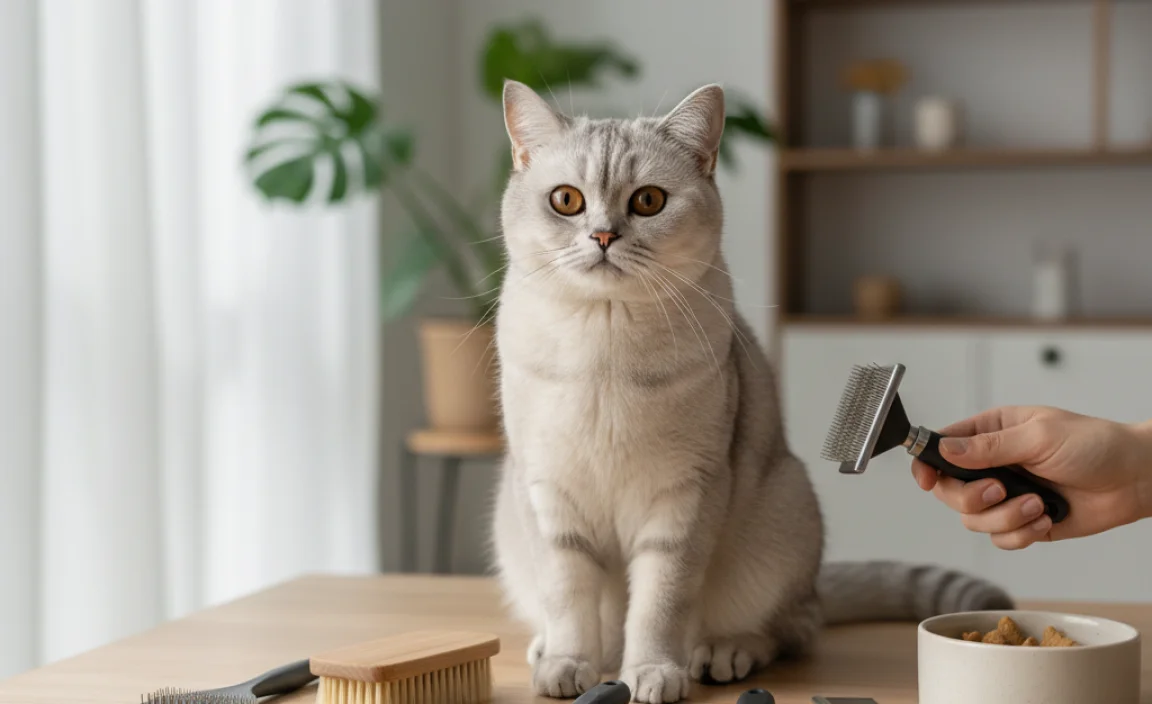
Using the right brush can make all the difference in your grooming routine. Here are some top recommendations for British Shorthairs:
- Slicker Brush: Ideal for removing loose fur and preventing mats. Look for one with fine, angled bristles.
- Undercoat Rake: Designed to reach deep into the coat and remove loose undercoat. This is especially useful during shedding season.
- Grooming Glove: A gentle option for cats who are sensitive to brushing. It allows you to pet and groom them simultaneously.
- Metal Comb: Great for detangling and smoothing the coat after brushing.
Brush Comparison Table
| Brush Type | Best For | Pros | Cons |
|---|---|---|---|
| Slicker Brush | Removing loose fur and preventing mats | Effective, easy to use | Can be too harsh if used improperly |
| Undercoat Rake | Removing loose undercoat during shedding season | Reaches deep into the coat | May not be suitable for cats with sensitive skin |
| Grooming Glove | Gentle grooming for sensitive cats | Comfortable, easy to use | Less effective for heavy shedding |
| Metal Comb | Detangling and smoothing the coat | Gentle, effective for finishing | Not ideal for removing large amounts of fur |
Step-by-Step Guide to Brushing Your British Shorthair

Now that you know how often to brush and which tools to use, let’s dive into the actual brushing process. Here’s a step-by-step guide to make grooming a positive experience for your cat:
Step 1: Gather Your Supplies
Before you start, gather all the necessary supplies:
- Brush(es) of your choice
- Treats
- Towel or grooming mat
Step 2: Create a Calm Environment
Choose a quiet, comfortable space where your cat feels safe. Avoid noisy areas or places with a lot of activity. A calm environment will help your cat relax and enjoy the grooming session.
Step 3: Start Slowly
If your cat is new to brushing, start slowly and gradually introduce the brush. Let them sniff and rub against the brush to get used to it. Offer treats and praise to create positive associations.
Step 4: Brush Gently
Begin by gently brushing your cat in the direction of their fur growth. Use short, gentle strokes to avoid pulling or irritating their skin. Pay attention to areas prone to matting, such as behind the ears, under the legs, and around the tail.
Step 5: Use Different Brushes
Depending on your cat’s coat condition and the season, switch between different brushes. Use the slicker brush to remove loose fur, the undercoat rake to tackle shedding, and the metal comb to detangle and smooth the coat.
Step 6: Reward Your Cat
Throughout the grooming session, offer treats and praise to reward your cat for their cooperation. End the session on a positive note, even if you only brushed for a few minutes.
Step 7: Clean Your Brush
After each grooming session, clean your brush to remove any accumulated fur. This will keep the brush in good condition and prevent the spread of bacteria. Some brushes can be washed with soap and water, while others may require a special cleaning tool.
Dealing with Mats and Tangles
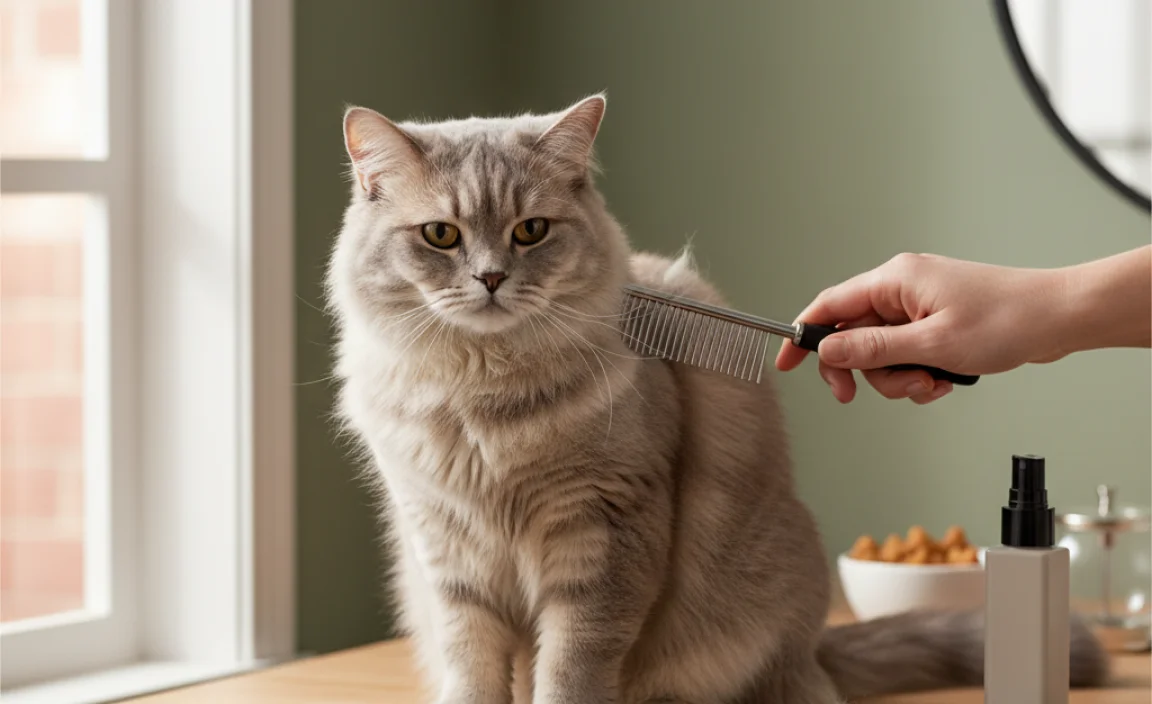
Despite regular brushing, mats and tangles can still occur. Here’s how to handle them safely and effectively:
Prevention is Key
The best way to deal with mats is to prevent them from forming in the first place. Regular brushing, especially during shedding season, can significantly reduce the risk of matting.
Gentle Detangling
If you find a small tangle, try to gently detangle it with your fingers or a wide-toothed comb. Be patient and avoid pulling or yanking, which can be painful for your cat.
Mat Splitter or Detangling Tool
For more stubborn mats, consider using a mat splitter or detangling tool. These tools are designed to carefully cut through the mat without damaging the surrounding fur.
Professional Grooming
If the mats are severe or widespread, it’s best to seek professional help from a groomer or veterinarian. They have the expertise and tools to safely remove mats without causing your cat discomfort.
Bathing Your British Shorthair
While British Shorthairs are generally clean cats, occasional bathing can help keep their coat healthy and shiny. However, avoid over-bathing, as it can strip their skin of natural oils and lead to dryness.
How Often to Bathe
Generally, you only need to bathe your British Shorthair every few months, or when they get particularly dirty. Unless your cat has a skin condition that requires more frequent baths, less is more.
Bathing Tips
- Use a Cat-Specific Shampoo: Human shampoos can be too harsh for cats and may irritate their skin.
- Brush Before Bathing: Brushing before bathing helps remove loose fur and prevent mats from forming.
- Warm Water: Use lukewarm water to avoid shocking your cat.
- Rinse Thoroughly: Make sure to rinse all the shampoo out of their coat.
- Dry Gently: Use a soft towel to gently dry your cat. You can also use a low-heat hairdryer, but be careful not to overheat their skin.
Grooming for Senior British Shorthairs
As British Shorthairs age, their grooming needs may change. Senior cats may have difficulty grooming themselves due to arthritis or other health issues. Here’s how to adapt your grooming routine to meet their needs:
- More Frequent Brushing: Senior cats may need more frequent brushing to compensate for their decreased grooming ability.
- Gentle Approach: Use a soft brush and gentle strokes to avoid causing discomfort.
- Shorter Sessions: Break up grooming sessions into shorter, more frequent intervals to avoid tiring your cat.
- Check for Skin Issues: Regularly check your cat’s skin for any signs of irritation, dryness, or infection.
- Consult Your Veterinarian: If you notice any significant changes in your cat’s coat or skin, consult your veterinarian.
The Benefits of Professional Grooming
While you can certainly groom your British Shorthair at home, professional grooming offers several benefits:
- Expertise: Professional groomers have the knowledge and experience to properly care for your cat’s coat and skin.
- Specialized Tools: Groomers have access to specialized tools and products that can improve your cat’s coat health.
- Thorough Grooming: Groomers can provide a more thorough grooming session, including bathing, trimming, and nail care.
- Health Check: Groomers can identify potential health issues, such as skin problems or parasites, and alert you to seek veterinary care.
How to Choose a Groomer
If you decide to use a professional groomer, here are some tips for choosing the right one:
- Ask for Recommendations: Ask your veterinarian, friends, or other cat owners for recommendations.
- Check Credentials: Look for groomers who are certified or have experience with British Shorthairs.
- Visit the Facility: Visit the grooming facility to ensure it is clean, safe, and well-maintained.
- Discuss Your Cat’s Needs: Talk to the groomer about your cat’s specific needs and preferences.
Making Grooming a Positive Experience
The key to successful grooming is to make it a positive experience for your cat. Here are some tips to help you create a stress-free grooming routine:
- Start Young: Introduce grooming to your cat as early as possible, ideally when they are kittens.
- Be Patient: Be patient and understanding, especially if your cat is resistant to grooming.
- Use Positive Reinforcement: Reward your cat with treats, praise, and affection during and after grooming sessions.
- Keep Sessions Short: Start with short grooming sessions and gradually increase the duration as your cat becomes more comfortable.
- End on a Positive Note: Always end the grooming session on a positive note, even if you only brushed for a few minutes.
Common Grooming Mistakes to Avoid
Even with the best intentions, it’s easy to make mistakes when grooming your British Shorthair. Here are some common pitfalls to avoid:
- Using the Wrong Brush: Using the wrong brush can be ineffective or even harmful to your cat’s coat.
- Brushing Too Hard: Brushing too hard can irritate your cat’s skin and cause discomfort.
- Ignoring Mats: Ignoring mats can lead to pain, skin irritation, and potential infections.
- Over-Bathing: Over-bathing can strip your cat’s skin of natural oils and lead to dryness.
- Forcing Grooming: Forcing grooming can create negative associations and make your cat resistant to future sessions.
Resources and Further Reading
For more information on British Shorthair care and grooming, check out these resources:
- The International Cat Association (TICA)
- RSPCA
- Purina – British Shorthair
- Cornell Feline Health Center
FAQ About Brushing British Shorthairs
How do I know if I’m brushing my British Shorthair enough?
A good sign is minimal loose fur around your home and a tangle-free coat. If you notice frequent mats or excessive shedding, increase the brushing frequency.
What if my British Shorthair hates being brushed?
Start slowly with short sessions, use treats, and try different types of brushes to find one they like. Positive reinforcement is key!
Can I use human shampoo on my British Shorthair?
No, human shampoo can irritate their skin. Always use a shampoo specifically formulated for cats.
How can I prevent hairballs in my British Shorthair?
Regular brushing is the best way to reduce hairballs, as it removes loose fur before your cat can ingest it while grooming.
Is it normal for my British Shorthair to shed a lot?
British Shorthairs have a dense coat and are moderate shedders. Shedding increases during spring and fall. Regular brushing can manage this.
What are the signs of a skin problem in my British Shorthair?
Look for redness, itching, bald patches, or excessive grooming. Consult your vet if you notice any of these signs.
At what age should I start brushing my British Shorthair kitten?
Start as early as possible to get them used to the sensation. Gentle brushing from kittenhood will make grooming easier as they grow.
Conclusion
Regular brushing is a crucial part of caring for your British Shorthair. By following the tips and guidelines in this article, you can keep their coat healthy, reduce shedding, and strengthen your bond with your feline friend. Remember to adjust your brushing routine based on your cat’s individual needs and preferences. With a little patience and consistency, you can make grooming a positive experience for both you and your British Shorthair. Happy grooming!




